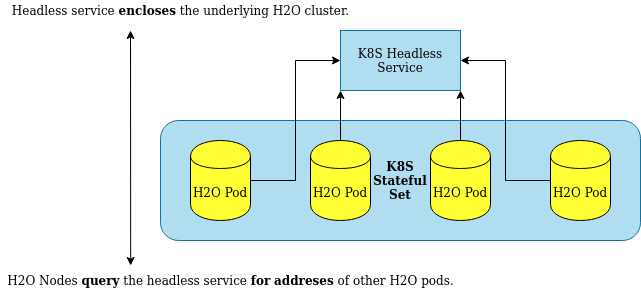Kubernetes users¶
H2O-3 nodes must be treated as stateful by the Kubernetes environment because H2O-3 is a stateful application. H2O-3 nodes are, therefore, spawned together and deallocated together as a single unit. Subsequently, Kubernetes tooling for stateless applications is not applicable to H2O-3. In Kubernetes, a set of pods sharing a common state is named a StatefulSet.
H2O-3 pods deployed on a Kubernetes cluster require a headless service for H2O-3 node discovery. The headless service returns a set of addresses to all the underlying pods instead of load-balancing incoming requests to the underlying H2O-3 pods.

Kubernetes integration¶
This section outlines how to integrate H2O-3 and Kubernetes.
Requirements¶
To spawn an H2O-3 cluster inside of a Kubernetes cluster, you need the following:
Create the Docker image¶
A simple Docker container with H2O-3 running on startup is enough:
FROM ubuntu:latest
ARG H2O_VERSION
RUN apt-get update \
&& apt-get install default-jdk unzip wget -y
RUN wget http://h2o-release.s3.amazonaws.com/h2o/rel-zahradnik/1/h2o-${H2O_VERSION}
&& unzip h2o-${H2O_VERSION}.zip
ENV H2O_VERSION ${H2O_VERSION}
CMD java -jar h2o-${H2O_VERSION}/h2o.jar
To build the Docker image, user docker build . -t {image-name} --build-arg H2O_VERSION=<h2o-version>. Make sure to replace {image-name} with the meaningful H2O deployment name and <h2o-version> with your H2O version.
Note
For the rest of this example, the docker image will be named h2o-k8s.
Create the headless service¶
First, create a headless service on Kubernetes:
apiVersion: v1
kind: Service
metadata:
name: h2o-service
namespace: default
spec:
type: ClusterIP
clusterIP: None
selector:
app: h2o-k8s
ports:
- protocol: TCP
port: 54321
Where:
clusterIP: None: This setting defines the service as headless.port: 54321: This setting is the default H2O-3 port. Users and client libraries use this port to talk to the H2O-3 cluster.app: h2o-k8s: This setting is of great importance because it is the name of the application with the H2O-3 pods inside. While the name is arbitrarily chosen in this example, it must correspond to the chosen H2O-3 deployment name.
Create the H2O-3 deployment¶
We strongly recomming you run H2O-3 as a StatefulSet on your Kubernetes cluster. Treating H2O-3 nodes as stateful ensures the following:
H2O-3 nodes will be treated as a single unit and will be brought up and down gracefully and together.
No attempts will be made by a Kubernetes healthcheck to restart individual H2O-3 nodes in case of an error.
The cluster will be restarted as a whole, if required.
Persistent storages and volumes associated with the StatefulSet of H2O-3 nodes will not be deleted once the cluster is brought down.
apiVersion: apps/v1
kind: StatefulSet
metadata:
name: h2o-stateful-set
namespace: default
spec:
serviceName: h2o-service
podManagementPolicy: "Parallel"
replicas: 3
selector:
matchLabels:
app: h2o-k8s
template:
metadata:
labels:
app: h2o-k8s
spec:
terminationGracePeriodSeconds: 10
containers:
- name: h2o-k8s
image: 'h2oai/h2o-open-source-k8s:latest'
resources:
requests:
memory: "4Gi"
ports:
- containerPort: 54321
protocol: TCP
env:
- name: H2O_KUBERNETES_SERVICE_DNS
value: h2o-service.default.svc.cluster.local
- name: H2O_NODE_LOOKUP_TIMEOUT
value: '180'
- name: H2O_NODE_EXPECTED_COUNT
value: '3'
Where:
H2O_KUBERNETES_SERVICE_DNS: Required Crucial for clustering to work. This format usually follows the<service-name>.<project-namespace>.svc.cluster.localpattern. This setting enables H2O-3 node discovery through DNS. It must be modified to match the name of the headless service you created. Be sure you also pay attention to the rest of the address: it needs to match the specifics of your Kubernetes implementation.H2O_NODE_LOOKUP_TIMEOUT: Node lookup constraint. Specify the time before the node lookup times out.H2O_NODE_EXPECTED_COUNT: Node lookup constraint. Specify the expected number of H2O-3 pods to be discovered.H2O_KUBERNETES_API_PORT: Port for Kubernetes API checks to listen on (defaults to8080).
If none of these optional lookup constraints are specified, a sensible default node lookup timeout will be set (defaults to three minutes). If any of the lookup constraints are defined, the H2O-3 node lookup is terminated on whichever condition is met first.
In the above example, 'h2oai/h2o-open-source-k8s:latest' retrieves the latest build of the H2O-3 Docker image. Replace latest with nightly to get the bleeding-edge Docker image with H2O-3 inside.
Documentation¶
The documentation for the official H2O-3 Docker images is available at the official H2O-3 Docker Hub page.
Expose the H2O-3 cluster¶
Exposing the H2O-3 cluster is the responsibility of the Kubernetes administrator. By default, an Ingress can be created. Different platforms offer different capabilities (e.g. OpenShift offers Routes).
See more information on running an H2O-3 cluster on a Kubernetes cluster.